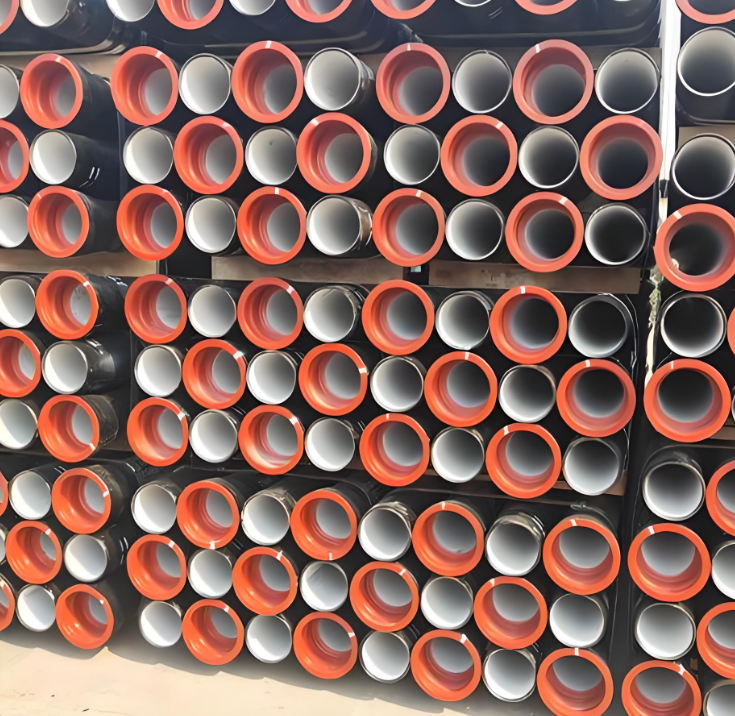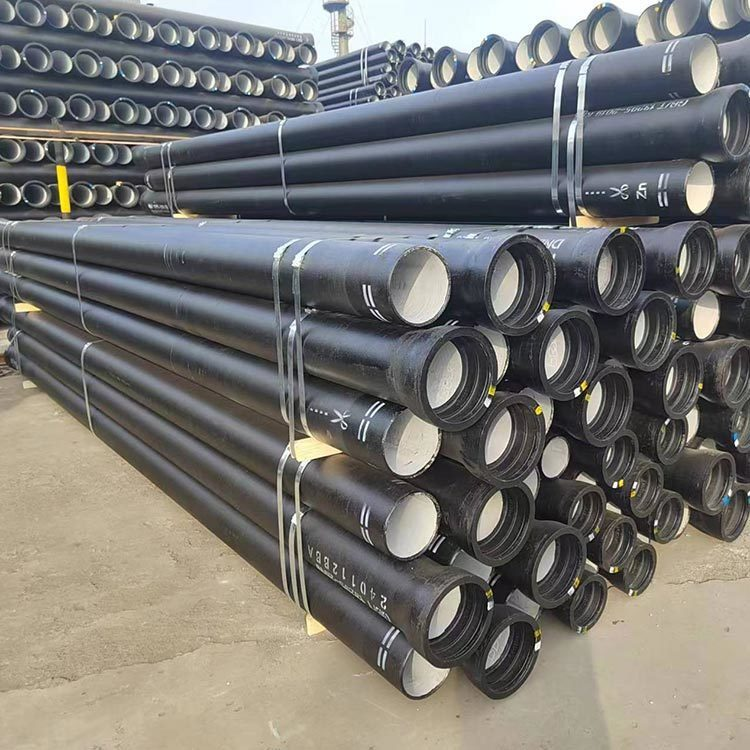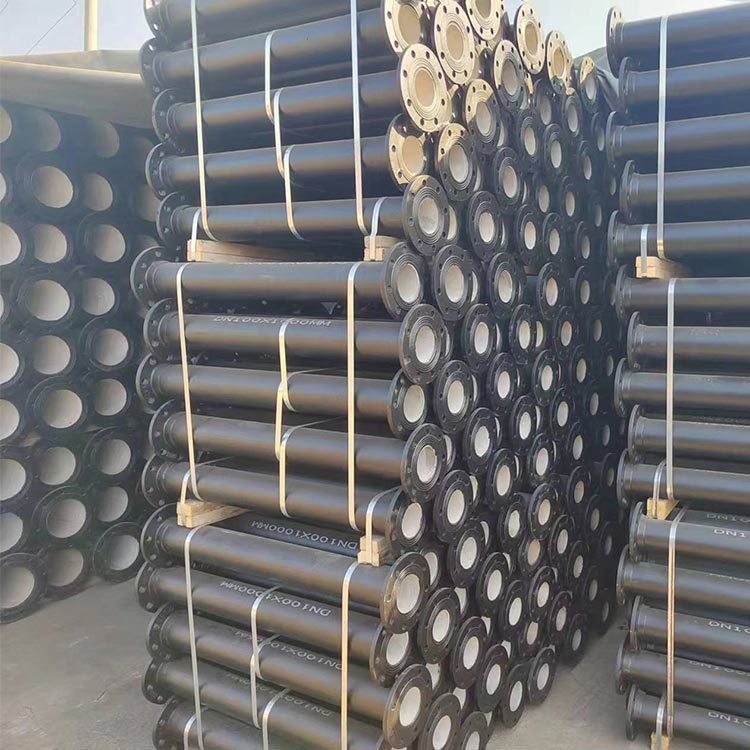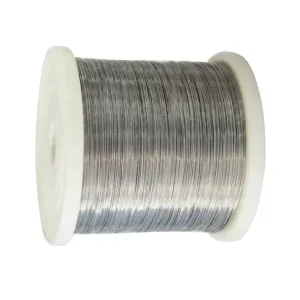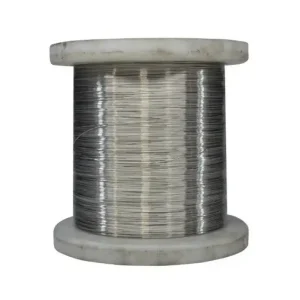Epoxy coated ductile iron pipe integrates the mechanical robustness of ductile iron with a bonded polymer layer, delivering superior corrosion resistance for aggressive fluid transport. The pipe’s base material—engineered with spheroidal graphite microstructure—provides high tensile strength (≥420 MPa) and flexibility, while the internally/externally applied epoxy coating (200–500 μm) forms an impervious barrier against chemical, abrasive, and electrochemical degradation. This hybrid design ensures longevity in demanding applications including potable water, industrial effluents, mining slurries, and high-salinity environments, exceeding 50 years of service life under ISO 2531 and NSF/ANSI 61 compliance.
Epoxy-Coated Ductile Iron Pipe Specifications
| Parameter Category | Specification/Value | Standards/Remarks |
|---|---|---|
| Basic Specifications | ||
| Nominal Diameter (DN) | DN 80 – DN 2600 mm | Customizable per project 1 |
| Effective Length | 5.5 m, 5.7 m, 6.0 m | 6.0 m most common 1 |
| Wall Thickness Grade | K7, K8, K9, C25, C30, C40 | K9 for high-pressure (≤3.5 MPa); K7 for low-pressure (≤1.0 MPa) 17 |
| Joint Types | T-type (Push-on), K-type (Mechanical), Flanged | Gaskets: SBR/EPDM/NBR rubber (ISO 4633 certified) 1 |
| Mechanical Properties | ||
| Tensile Strength (min) | ≥ 420 MPa | ISO 6892-1 1 |
| Yield Strength (min) | ≥ 300 MPa | ISO 6892-1 (0.2% proof stress) 1 |
| Elongation (min) | ≥ 10% | 50mm gauge length 1 |
| Hardness | ≤ 230 HB | Brinell scale 1 |
| Epoxy Coating Properties | ||
| Coating Types | Fusion-Bonded Epoxy (FBE), Solvent-Free Phenolic Epoxy Ceramic, Liquid Epoxy | Ceramic epoxy for high abrasion/heat 47 |
| Internal Coating Thickness | 200–400 μm (FBE); 300–800 μm (Ceramic) | ≥300 μm for corrosion resistance 35 |
| External Coating Thickness | 200–500 μm | Optional: Zinc undercoat (130 g/m²) + epoxy top layer 12 |
| Adhesion Strength | ≥ 30 N/10mm | JIS G 5528 5 |
| Surface Roughness (C-factor) | Hazen-Williams C = 130–140 | Smooth finish reduces hydraulic friction 7 |
| Volume Solids Content | ≥ 98% (Solvent-free ceramic epoxy) | Low VOC; enhances density/corrosion resistance 4 |
| Testing & Certification | ||
| Hydrostatic Test Pressure | ≥ 5.0 MPa (min) | 2× working pressure 1 |
| Coating Adhesion Test | No cracking/spalling after impact | GB/T 34202, ISO 18468 76 |
| Temperature Resistance | -30°C to +100°C (FBE); ≤150°C (Ceramic) | Ceramic epoxy for high-temp fluids 47 |
| Chemical Resistance | Passes 500-hr salt spray test (ISO 9227) | No blistering/corrosion 5 |
| Water Safety Certifications | NSF/ANSI 61, KTW, WRAS | Potable water compliant 37 |
| Performance & Lifespan | ||
| Max. Working Pressure | ≤ 3.5 MPa (K9 grade) | Pressure class-dependent 1 |
| Abrasion Resistance | Hardness ≥2H (pencil test) | Suitable for slurry/aggressive media 3 |
| Design Service Life | ≥ 50 years | With proper installation 7 |
| Soil Corrosion Resistance | Suitable for pH 4–10 soils | External epoxy/zinc-bitumen hybrid coating 27 |
Epoxy Coating Process
We employ a fusion-bonded epoxy (FBE) system:
-
Surface Preparation: Blast-cleaning to Sa 2½ (ISO 8501-1).
-
Epoxy Application: FBE powder sprayed at 200–240 °C.
-
Curing: Controlled oven cycle, ensuring 400 μm minimum thickness externally and 250 μm internally.
-
Quality Control: Holiday detection, cross-hatch adhesion test, and impact resistance test. Our industry partners report coating adhesion values >8 MPa per ISO 24624.
Global Price Comparison
| Region | Price per Meter (USD) | Currency Date | Supplier Reference |
|---|---|---|---|
| China | 25–30 | Jul 2025 | MWalloys (factory) |
| India | 28–33 | Jul 2025 | Local foundry |
| Europe | 40–45 | Jul 2025 | Multiple vendors |
| Middle East | 32–37 | Jul 2025 | Regional stockists |
| North America | 38–42 | Jul 2025 | Importers & mills |
Application Scenarios
Whether supplying potable water, sewage conveyance, or industrial process lines, our epoxy coated pipes excel. In municipal networks, they combat chlorides and soil aggression. In petrochemical plants, they withstand chemicals and mechanical loading. Moreover, in irrigation systems, they minimize biofouling.
- Potable Water Transmission and Distribution.
- Wastewater and Sewerage Systems.
- Irrigation Systems.
- Fire Protection Systems.
- Industrial Piping.
- Pump Stations and Treatment Plants.
Installation Technical Specifications
Proper installation is paramount to harnessing the full potential of MWalloys epoxy coated ductile iron pipe and ensuring its longevity. We've developed comprehensive guidelines that streamline the installation process while upholding the highest standards of safety and efficiency. This isn't just about laying pipe; it's about building a durable system.
- Trenching and Bedding:
- Trench Width: Trenches should be wide enough to allow for proper joint assembly and compaction of bedding material, typically the pipe's outer diameter plus 300 mm on each side.
- Trench Depth: Depth must accommodate the pipe's outer diameter, bedding material (100−150 mm minimum), and adequate cover (0.9−1.2 meters minimum in most applications, but varies by location and loading).
- Bedding Material: We strongly recommend using granular material, such as crushed stone or sand, free from organic matter and sharp objects. This provides uniform support and prevents point loading on the pipe. The bedding should be compacted to a minimum of 90 Standard Proctor Density.
- Handling and Laying:
- Handling: Pipes should be lifted using appropriate slings or lifting equipment to prevent damage to the pipe barrel or coating. Avoid dropping pipes or dragging them over rough surfaces.
- Laying: Pipes should be laid with the bell end facing in the direction of laying. Ensure proper alignment to facilitate joint assembly.
- Cutting: If cutting is necessary, use an abrasive wheel or similar tool that produces a clean, straight cut without damaging the epoxy lining. Re-coat any exposed metal with an approved repair kit.
- Joint Assembly:
- Cleaning: Thoroughly clean the spigot and bell ends of debris.
- Lubrication: Apply a generous amount of approved lubricant to the gasket and the spigot end.
- Insertion: Align the spigot with the bell and push the spigot into the bell until it reaches the insertion mark. For larger diameters, a pipe puller or backhoe may be required.
- Inspection: Verify the gasket is properly seated and the joint is fully home.
- Backfilling and Compaction:
- Initial Backfill (Haunching and Initial Cover): Carefully place backfill material, typically selected native soil or granular material, around the haunches of the pipe and up to 300 mm above the pipe crown. Compact in layers (150−200 mm lifts) using manual tampers or light vibratory compactors to achieve 90 Standard Proctor Density. Avoid heavy compaction equipment directly over the pipe.
- Final Backfill: The remainder of the trench can be backfilled with suitable native material, compacted to achieve specified density.
- Warning Tapes: Install detectable warning tapes approximately 300 mm below finished grade for future utility identification.
- Pressure Testing:
- Isolation: Isolate the section to be tested.
- Filling and Purging: Slowly fill the pipeline with water, ensuring all air is purged from the system through air release valves.
- Pressurization: Gradually increase pressure to the specified test pressure, typically 1.5 times the working pressure, holding for a minimum of 2 hours.
- Leakage Allowance: Adhere to established leakage allowances (e.g., AWWA C600, EN 805) to determine test success. Any visible leaks must be repaired.
- Corrosion Protection (External): While our epoxy coating provides substantial protection, in highly corrosive soils, supplemental corrosion protection measures may be considered, such as polyethylene encasement (loose or tight wrap) or cathodic protection. Our technical team can advise on specific requirements based on soil resistivity and other factors.
Frequently Asked Questions
-
What is the design life of MWalloys epoxy coated ductile iron pipe?
We engineer our epoxy coated DI pipe for a minimum service life of 100 years when installed and maintained per recommended guidelines. This estimate assumes correct trench bedding, periodic pressure testing, and adherence to our specified backfill materials. Field studies have demonstrated pipelines still performing optimally after 80+ years in moderate soil conditions, underscoring the longevity of the fusion-bonded epoxy barrier and ductile iron core. -
Which pressure classes are available, and how do they differ?
We offer standard pressure ratings of PN 10, PN 16, and PN 25 (equivalent to 10 bar, 16 bar, and 25 bar service pressures). PN 10 handles typical municipal water supply; PN 16 suits elevated residential or commercial zones; PN 25 addresses high-rise or industrial demands. Each class is achieved by varying wall thickness per ISO 2531, ensuring consistent mechanical strength and safety factors across diameters. -
How does the fusion‑bonded epoxy lining enhance performance?
Our FBE lining provides three key benefits:-
Corrosion immunity: It isolates the iron substrate from aggressive water chemistry, reducing corrosion rate to under 0.02 mm/year in neutral pH soils.
-
Hydraulic smoothness: A uniform, pore-free interior yields Manning’s n of ~0.012, minimizing friction losses and cutting pumping energy by up to 8 %.
-
Wear resistance: Thick epoxy resists abrasion from sand-laden flows; testing per ASTM D4060 shows material loss <0.5 g after 1,000 cycles.
-
-
What jointing methods do you support, and how do they impact installation?
We supply two joint types:-
Socket-and-spigot with rubber seal: The most common, allowing 4–5° deflection per joint, ideal for pipelines with alignment challenges.
-
Mechanical restraint (Mega-lug™ style): For high-pressure or thrust-critical applications, these prevent joint separation under surge. Installation follows our technical bulletin: clean sealing surfaces, apply lubricant sparingly, align internally, and verify seating marks.
-
-
How should I test and maintain the pipeline after installation?
Upon laying and backfilling:-
Perform hydrostatic testing at 1.5× PN for 2 hours; pressure drop must remain under 5 % of initial.
-
Conduct holiday detection (spark test) on external coating to locate any pinholes; repair per ISO 21809.
-
Inspect internal lining via CCTV: look for cracking or debonding at joints.
Thereafter, schedule biennial pressure checks and pigging (for potable systems) to remove sediment—this preserves flow capacity and prevents microbial accumulation.
-
-
What environmental considerations apply to epoxy coated ductile iron pipe?
We prioritize sustainability: ductile iron is 100 % recyclable at end‑of‑life. Our epoxy is solvent‑free, low‑VOC, and complies with NSF/ANSI 61 for drinking water contact. Moreover, lifecycle assessments indicate DI pipe’s CO₂ footprint is comparable or lower than alternatives when factoring in long service life and reduced maintenance interventions.

